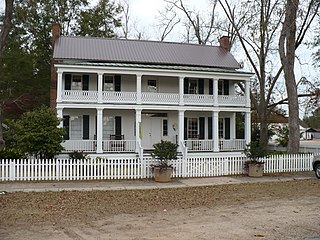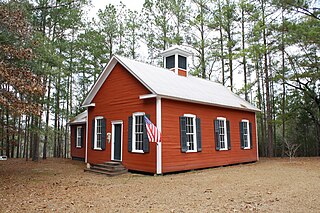
This is a list of the National Register of Historic Places listings in Clarke County, Alabama.

St. Luke's Episcopal Church is a historic Carpenter Gothic church, built during the 1850s at Cahaba, the first capital of Alabama from 1820 to 1826. The unknown builder closely followed plans published by architect Richard Upjohn in his 1852 book Rural Architecture.

Prospect House, known also as just Prospect, is a historic house on the Princeton University campus in Princeton, Mercer County, New Jersey, United States. Built in 1851, it is a fine example of the work of architect John Notman who helped popularize Italianate architecture in America. Notable residents include Woodrow Wilson during his tenure as president of the university. The building now serves as a faculty club. It was designated a National Historic Landmark in 1985 for its architecture and historic associations.

The Alston–Cobb House, now formally known as the Clarke County Historical Museum, is a historic house and local history museum in Grove Hill, Alabama, United States. It was built in 1854 by Dr. Lemuel Lovett Alston as a Greek Revival I-house, a vernacular style also known in the South as Plantation Plain. It is one of only four examples of an I-house to survive intact in Clarke County. The Alston–Cobb House was added to the Alabama Register of Landmarks and Heritage on September 1, 1978, and to the National Register of Historic Places on April 30, 1979.

The Thomasville Historic District is a historic district in the city of Thomasville, Alabama, United States. Thomasville was founded in 1888, along the then newly constructed railroad between Mobile and Selma. The city's business district suffered a major fire in 1899, with only one brick building surviving. The historic district features examples of early commercial, Queen Anne, Colonial Revival, Craftsman, and regional vernacular architecture. The historic district is centered on the old business district and is roughly bounded by U.S. Highway 43, West Front Street, Wilson Street, and West Third Street. It is a part of the Clarke County Multiple Property Submission and was placed on the National Register of Historic Places on February 12, 1999.

Roseland Plantation is a historic plantation complex site in Faunsdale, Alabama. The site is situated on a low hill at the end of a long driveway on the overgrown estate. It was added to the National Register of Historic Places on January 20, 1994, as a part of the Plantation Houses of the Alabama Canebrake and Their Associated Outbuildings Multiple Property Submission.

The Bush House is a historic house in Grove Hill, Alabama, United States. The two-story Colonial Revival style house was built in 1912. It was added to the National Register of Historic Places on July 28, 1999. It was listed due to its architectural significance as a part of the Clark County Multiple Property Submission.

The John A. Coate House is a historic house located in Grove Hill, Alabama, United States.

The Cobb House is a historic house near Grove Hill, Alabama, United States. The two-story I-house was built in 1865. It was added to the Alabama Register of Landmarks and Heritage on January 29, 1980, and subsequently to the National Register of Historic Places on July 28, 1999. It was listed due to its architectural significance as a part of the Clarke County Multiple Property Submission.

The Grover Cleveland Birthplace is a historic site located at 207 Bloomfield Avenue in Caldwell, Essex County, New Jersey, United States. It is the only house museum dedicated to U.S. President Grover Cleveland.

The Stone Plantation, also known as the Young Plantation and the Barton Warren Stone House, is a historic Greek Revival-style plantation house and one surviving outbuilding along the Old Selma Road on the outskirts of Montgomery, Alabama. It had been the site of a plantation complex, and prior to the American Civil War it was known for cotton production worked by enslaved people.

The Willis G. Clark House is a historic house located in Northern Mobile County, Alabama.

The Wilson–Finlay House also known as the Joshua Wilson House and the Finlay House, is a historic plantation house in Gainestown, Alabama, United States. It was added to the Alabama Register of Landmarks and Heritage on September 17, 1976. It was placed on the National Register of Historic Places on July 12, 1978, due to its architectural significance.

The Gainestown Schoolhouse is a historic school building on Clarke County Road 29 in Gainestown, Alabama, United States. It was built in 1919 as a one-room schoolhouse and now serves as a guesthouse for the Wilson-Finlay House across the road. It was placed on the National Register of Historic Places on October 1, 1992, due to its architectural significance.

The Jackson Historic District is a historic district in the city of Jackson, Alabama, United States. Jackson was founded in 1816 and is the oldest incorporated settlement in Clarke County. The historic district features examples of Greek Revival, Queen Anne, Colonial Revival, and regional vernacular architecture. Spread over 180 acres (73 ha) with 140 contributing buildings, it is roughly bounded by College Avenue, Forest Avenue, Carroll Avenue, Cedar Street, Florida Street, Commerce Street, Clinton Street, and Spruce Street. It is a part of the Clarke County Multiple Property Submission and was placed on the National Register of Historic Places on January 23, 1998.

The Jesse Pickens Pugh Farmstead is a historic 289-acre (117 ha) homestead near Grove Hill in rural Clarke County, Alabama, United States. The homestead contains seven contributing buildings, two contributing sites, and one contributing structure. These include a half-spraddle roof cottage that was built in 1865, agricultural outbuildings, agricultural fields, and burials. The complex was listed on the National Register of Historic Places on July 28, 1999, due to its architectural significance.

Woodlands, also known as the Frederick Blount Plantation, is a historic plantation house in Gosport, Alabama, United States. The house was added to the National Register of Historic Places on April 28, 1980, due to its architectural significance.

Suggsville is an unincorporated community in Clarke County, Alabama.
Harvey and Clarke was an American architectural firm formed by Henry Stephen Harvey and L. Philips Clarke in West Palm Beach, Florida, in 1921. The firm was active in South Florida for only a few years, but in that time designed a number of distinctive homes, apartments, churches, and commercial buildings. Harvey was a member of the West Palm Beach Planning Commission. Firm member Gustav Maass designed several railroad stations, and became a noted South Florida architect in his own right.

The Spur House is a historic house off Old Common Road in Dublin, New Hampshire. Built in 1901, it is a good local example of Colonial Revival architecture, designed by architect Charles A. Platt. The house was listed on the National Register of Historic Places in 1983.





















